Research on the Processes of Injecting CO2 into Coal Seams with CH4 Recovery Using Horizontal Wells
Abstract
1. Introduction
- Areas located beyond the coal seams belonging to operating coal mines, regardless of depth,
- Minimum depth below 1000 m, preferably 1250–1300 m,
- Methane content above 4.5 m3 CH4/Mgdaf, (preferably >8.0 m3 CH4/Mgdaf),
- Occurrence of claystone and mudstone formations in the Carboniferous strata above the CO2 storage as well as isolating formations of Carboniferous overburden,
- Low degree of urban development.
2. Materials and Methods
3. Results and Discussion
- θ = Scaling factor;
- Ps = Pressure at standard conditions;
- R = Universal gas constant;
- Ts = Temperature at standard conditions;
- Vi = Langmuir volume constant for component i;
- Pi = Langmuir pressure constant for component i;
- yi = Hydro carbon mole fraction in gas phase for component i;
- p = Pressure.
- mi = Molar density in the matrix coal;
- DIFFMF = Matrix fracture (or multi porosity) diffusivity;
- ρc = Rock density (coal density);
- Dc,i = Diffusion coefficient (coal) component i;
- RFi = Readsorption factor component i;
- Sg = Gas saturation, for desorption a value of unity is used;
- ρcLi = Equilibrium molar density of adsorbed gas.
4. Conclusions
Author Contributions
Funding
Conflicts of Interest
References
- Ridha, S.; Pratama, E.; Ismail, S.M. Performance assessment of CO2 sequestration in a horizontal well for enhanced coalbed methane recovery in deep unmineable coal seams. Chem. Eng. Trans. 2017, 56. [Google Scholar] [CrossRef]
- Sloss, L.L. Potential for Enhanced Coalbed Methane Recovery; IEA Clean Coal Centre: London, UK, 2015; ISBN 978-92-9029-574-7. [Google Scholar]
- Sams, W.N.; Bromhal, G.; Jikich, S.A.; Odusote, O.; Ertekin, T.; Smith, D.H. Simulation Carbon Dioxide Sequestration/ECBM Production in Coal Seams: Effects of Coal Properties and Operational Parameters; Paper SPE 78691; Society of Petroleum Engineers: Richardson, TX, USA, 2002. [Google Scholar]
- Wojtacha-Rychter, K.; Howaniec, N.; Smoliński, A. The effect of coal grain size on the sorption of hydrocarbons from gas mixtures. Int. J. Energy Res. 2019, 43, 3496–3506. [Google Scholar] [CrossRef]
- Wojtacha-Rychter, K.; Smoliński, A. Selective adsorption of ethane, ethylene, propane, and propylene in gas mixtures on different coal samples and implications for fire hazard assessments. Int. J. Coal Geol. 2019, 202, 38–45. [Google Scholar] [CrossRef]
- Wojtacha-Rychter, K.; Smoliński, A. The interactions between coal and multi-component gas mixtures in the process of coal self-heating at different various temperatures ranges: An experimental study. Fuel 2018, 213, 150–157. [Google Scholar] [CrossRef]
- Fang, H.; Snag, S.; Liu, S. Establishment of dynamic permeability model of coal reservoir and its numerical simulation during the CO2-ECBM process. J. Pet. Sci. Eng. 2019, 179, 885–898. [Google Scholar] [CrossRef]
- Du, Y.; Snag, S.; Pan, Z.; Wang, W.; Liu, S.; Fu, C.; Zhao, Y.; Zhang, J. Experimental study of supercritical CO2-H2O-coal interactions and the effect on coal permeability. Fuel 2019, 253, 369–382. [Google Scholar] [CrossRef]
- Więckowski, M.; Howaniec, N.; Postnikov, E.B.; Chorążewski, M.; Smoliński, A. Changes in the distribution of temperature in a coal deposit and the composition of gases emitted during its heating and cooling. Sustainability 2018, 10, 3587. [Google Scholar] [CrossRef]
- Howaniec, N.; Więckowski, M.; Smoliński, A. The effect of flow rates of gases flowing through a coal bed during coal heating and cooling on concentrations of gases emitted and fire hazard assessment. Int. J. Coal Sci. Technol. 2019. [Google Scholar] [CrossRef]
- Bromhal, G.S.; Sams, W.N.; Jikich, S.; Ertekin, T.; Smith, D.H. Simulation of CO2 sequestration in coalbeds: The effects of sorption isotherms. Chem. Geol. 2005, 217, 201–211. [Google Scholar] [CrossRef]
- Wong, S.; Gunter, W.D.; Mavor, M.J. Economics of CO2 sequestration in coalbed methane reservoirs. In Proceedings of the SPE/CERI Gas Technology Symposium, Calgary, AB, Canada, 3–5 April 2000; pp. 631–638. [Google Scholar]
- Stanton, R.; Froles, R.; Warwick, P.D.; Gluskoter, H. Coalbed sequestration of carbon dioxide. In Proceedings of the 1st National Conference on Carbon Sequestration, Washington, DC, USA, 14–17 May 2001. [Google Scholar]
- Krooss, B.; Van Bergen, F.; Gensterblum, Y.; Siemons, N.; Pagnier, H.; David, P. High-Pressure methane and carbon dioxide adsorption on dry and moisture equilibrated Pennsylvanian coals. Int. J. Coal Geol. 2002, 51, 69–92. [Google Scholar] [CrossRef]
- Shi, J.Q.; Durcan, S.; Sinka, I.C. Key parameters controlling coalbed methane cavity well performance. Int. J. Coal Geol. 2002, 49, 19–31. [Google Scholar] [CrossRef]
- Ceglarska-Stefańska, G.; Nodeński, A.; Hołda, S. Badania układu węgiel-gaz w aspekcie pozyskania metanu i sekwestracji CO2. Gos. Sur. Min. 2007, 23, 51–59. [Google Scholar]
- Mazzotti, M.; Pini, R.; Storti, G. Enhanced coalbed methane recovery. J. Supercrit. Fluids 2009, 47, 619–627. [Google Scholar] [CrossRef]
- Li, X.; Fang, Z.M. Current status and technical challenges of CO2 storage in coal seams and enhanced coalbed methane recovery. Int. J. Coal Sci. Technol. 2014, 1, 93–102. [Google Scholar] [CrossRef]
- Reeves, S.R. Coal-Seq Project Update: Fluid Studies of ECBM recovery/CO2 sequestration in coal seams. In Proceedings of the International Conference on Greenhouse Gas Control Technologies (GHGT.6), Kyoto, Japan, 1–4 October 2002. [Google Scholar]
- Reeves, S.R.; Outinot, A. The Tiffany unit N2-ECBM Pilot—A reservoir and economic analysis. In Proceedings of the International Coalbed Methane Symposium, Tuscaloosa, AL, USA, 16–20 May 2005. Paper 0523. [Google Scholar]
- Dutta, P.; Zoback, M.D. CO2 sequestration into the Wyodak coal seam of Powder River Basin—Preliminary reservoir characterization and simulation. Int. J. Greenh. Gas Control 2012, 9, 103–116. [Google Scholar] [CrossRef]
- Zdeb, J.; Howaniec, N.; Smoliński, A. Utilization of carbon dioxide in coal gasification—An experimental study. Energies 2019, 12. [Google Scholar] [CrossRef]
- Urych, T.; Smoliński, A. Numerical modeling of CO2 migration in saline aquifers of selected areas in the Upper Silesian Coal Basin in Poland. Energies 2019, 12, 3093. [Google Scholar] [CrossRef]
- Van Bergen, F.; Krzystolik, P.; Van Wageningen, N.; Pagnier, H.; Jura, B.; Skiba, J.; Winthaegen, P.; Kobiela, Z. Production of gas from coal seams in the Upper Silesian Coal Basin in Poland in the post injection period of an ECBM pilot site. Int. J. Coal Geol. 2009, 77, 175–187. [Google Scholar] [CrossRef]
- Van Bergen, F.; Winthaegen, P.; Pagnier, H.; Krzystolik, P.; Jura, B.; Skiba, J.; Van Wageningen, N. Assessment of CO2 storage performance of the enhanced coalbed methane pilot site in Kaniów. Energy Procedia 2009, 1, 3407–3414. [Google Scholar] [CrossRef][Green Version]
- Chadwick, A.; Arts, R.; Bernstone, C.; May, F.; Thibeau, S.; Zwigiel, R. Best Practice for the Storage of CO2 in Saline Aquifers, Observations and Guidelines from SACS and CO2STORE Projects; British Geological Survey: Nottingham, UK, 2006.
- Koteras, A.; Chećko, J.; Urych, T.; Magdziarczyk, M.; Smoliński, A. An assessment of the formations and structures suitable for safe CO2 geological storage in the Upper Silesian Coal Basin in Poland in the context of the regulation relating to the CCS. Energies 2020, 13, 195. [Google Scholar] [CrossRef]
- Jureczka, J.; Checko, J.; Krieger, W.; Warzecha, R. Feasibility study of CO2 storage in saline formations and structures of the Upper Silesian Coal Basin. Biul. Państwowego Inst. Geol. 2012, 448, 47–56. [Google Scholar]
- Larry, T. Coal Geology; John Wiley & Sons, Ltd.: Chichester, UK, 2002; p. 261. [Google Scholar]
- Arri, L.E.; Yee, D.; Morgan, W.D.; Jeansonne, N.W. Modeling Coalbed Methane Production with Binary Gas Sorption; SPE 24363; Society of Petroleum Engineers: Richardson, TX, USA, 1992. [Google Scholar]
- ECLIPSE User Manual; ECLIPSE Reservoir Simulation Software; Simulation Software Manuals 2011.1; Schlumberger: Houston, TX, USA, 2011.
- Wageningen, W.F.C.; Maas, J.G. Reservoir simulation and interpretation of the RECOPOL ECBM pilot in Poland. In Proceedings of the International CBM Symposium, Tuscaloosa, AL, USA, 23–24 May 2007. [Google Scholar]
- Mu, Y.; Fan, Y.; Wang, J.; Fan, M. Numerical study on injection of flue gas as heat carrier into coal reservoir to enhance CBM recovery. J. Nat. Gas. Sci. Eng. 2019, 72. [Google Scholar] [CrossRef]
- Mukherjee, M.; Misra, S.A. A review of experimental research on enhanced coal bed methane (ECBM) recovery via CO2 sequestration. Earth Sci Rev. 2018, 179, 392–410. [Google Scholar] [CrossRef]
- Cao, J.; Sun, H.T.; Dai, L.C.; Sun, D.L.; Wang, B.; Miao, F.T. Simulation research on dynamic effect of coal and gas outburst. J. China Univ. Min. Technol. 2018, 47, 113–120. [Google Scholar]
- Wahid, A.; Putra, F.A.; Taufiq Hidayt, M.; Yusuf, M. Enhanced coal bed methane (ECBM) recovery: Optimization of CBM production using different injected gas composition and rate for South Sumatra CBM field, Indonesia. E3S Web Conf. 2018, 67, 03015. [Google Scholar] [CrossRef]
- McCants, C.Y.; Spafford, S.; Stevens, S.H. Five-spot production pilot on tight spacing: Rapid evaluation of a coalbed methane block in the Upper Silesian Coal Basin, Poland. In Proceedings of the 2001 International Coalbed Methane Symposium University of Alabama, Tuscaloosa, AL, USA, 14–18 May 2001; Paper 0124. pp. 193–204. [Google Scholar]
- Reeves, S.; Taillefert, A. Reservoir Modeling for the Design of the RECOPOL CO2 Sequestration Project, Poland—Topical Report; Advanced Resources International: Houston, TX, USA, 2002. [Google Scholar]
- Pagnier, H.; van Bergen, F.; Krzystolik, P.; Skiba, J.; Jura, B.; Hadro, J.; Stevens, S. Field experiment of ECBM-CO2 in the Upper Silesian Basin of Poland (RECOPOL). Greenh. Gas Control Technol. 2005, 1391–1397. [Google Scholar] [CrossRef]
- Seidle, J.R.; Huitt, L.G. Experimental measurement of coal matrix shrinkage due to gas desorption andimplications for cleat permeability increases. In Proceedings of the International Meeting on Petroleum Engineering, Beijing, China, 14–17 November 1995. [Google Scholar] [CrossRef]
- Palmer, I.; Mansoori, J. How Permeability Depends on Stress and Pore Pressure in Coalbeds: A New Model; SPE Paper 36737; Society of Petroleum Engineers: Richardson, TX, USA, 1998. [Google Scholar]
- Moffat, D.H.; Weale, K.E. Sorption by coal of methane at high pressures. Fuel 1955, 34, 449–462. [Google Scholar]
- Reucroft, P.J.; Patel, H. Gas induced swelling in coal. Fuel 1986, 65, 816–820. [Google Scholar] [CrossRef]
- Gray, I. Reservoir engineering in coal seams: Part 1—The physical process of gas storage and movement in coal seams. SPE Reserv. Eval. Eng. 1987, 2, 12514. [Google Scholar] [CrossRef]
- Mitra, A.; Harpalani, S. Modeling incremental swelling of coal matrix with CO2 injection in coalbed Methane reservoirs. In Proceedings of the 2007 SPE Eastern Regional Meeting, Lexington, KY, USA, 17–19 October 2007. SPE Paper 111184. [Google Scholar]
- Chikatamarla, L.; Cui, X.; Bustin, R.M. Implications of volumetric swelling/shrinkage of coal in sequestration of acid gases. In Proceedings of the 2004 International Coalbed Methane Symposium, Tuscaloosa, AL, USA, 3–9 May 1999. [Google Scholar]
- Durucan, S.; Ahsanb, M.; Shia, J. Matrix shrinkage and swelling characteristics of European coals. Energy Procedia 2009, 1, 3055–3062. [Google Scholar] [CrossRef]
- Van Bergen, F. Effect of Coal Matrix Swelling on Enhanced Coalbed Methane Production: A Field and Laboratory Study. Ph.D. Thesis, Utrecht University, Utrecht, The Netherlands, 2009; p. 196. [Google Scholar]
- Mazumder, S.; Wolf, K.-H. Differential swelling and permeability change of coal in response to CO2 injection for ECBM. Int. J. Coal Geol. 2008, 74, 123–138. [Google Scholar] [CrossRef]
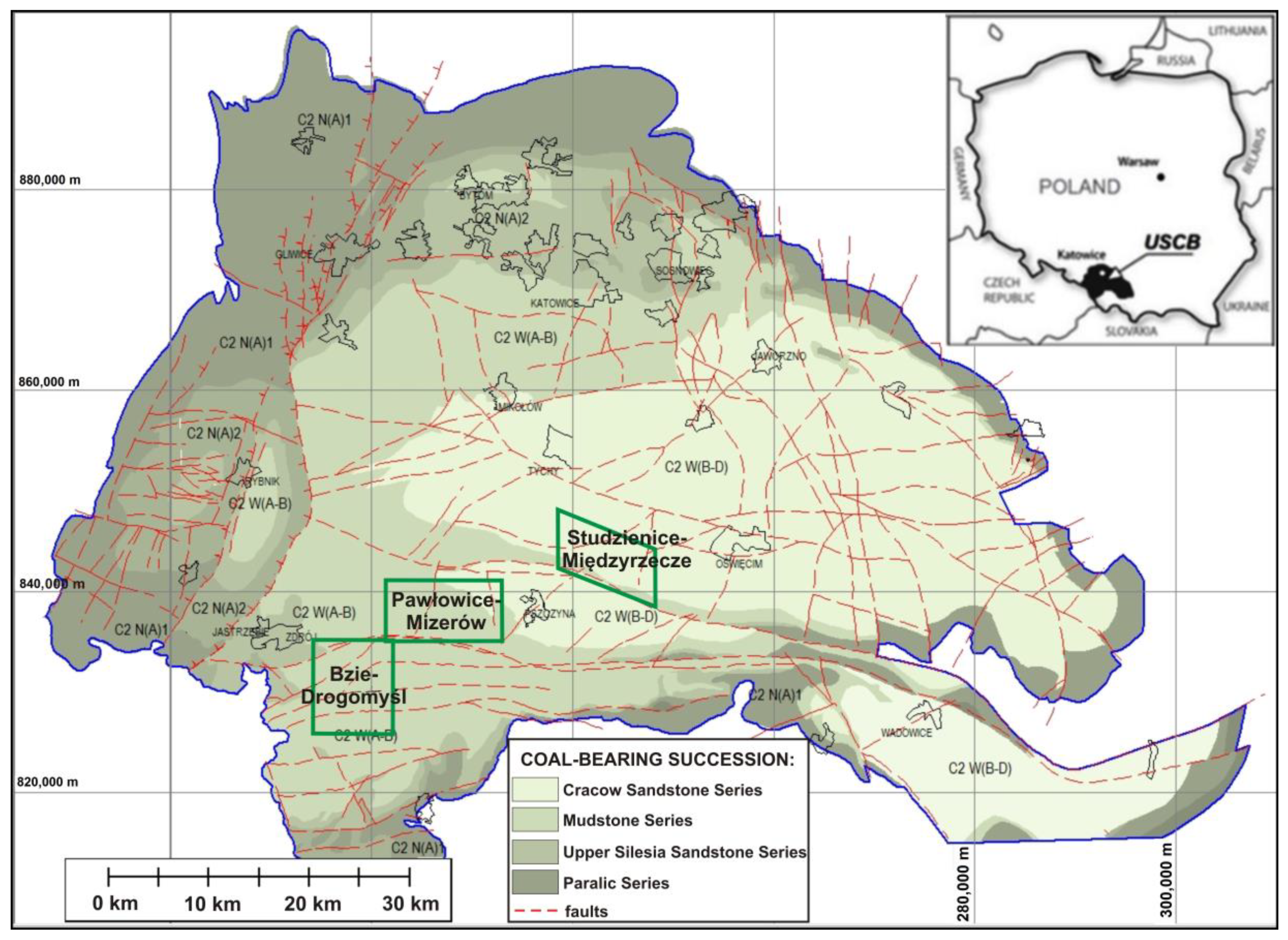
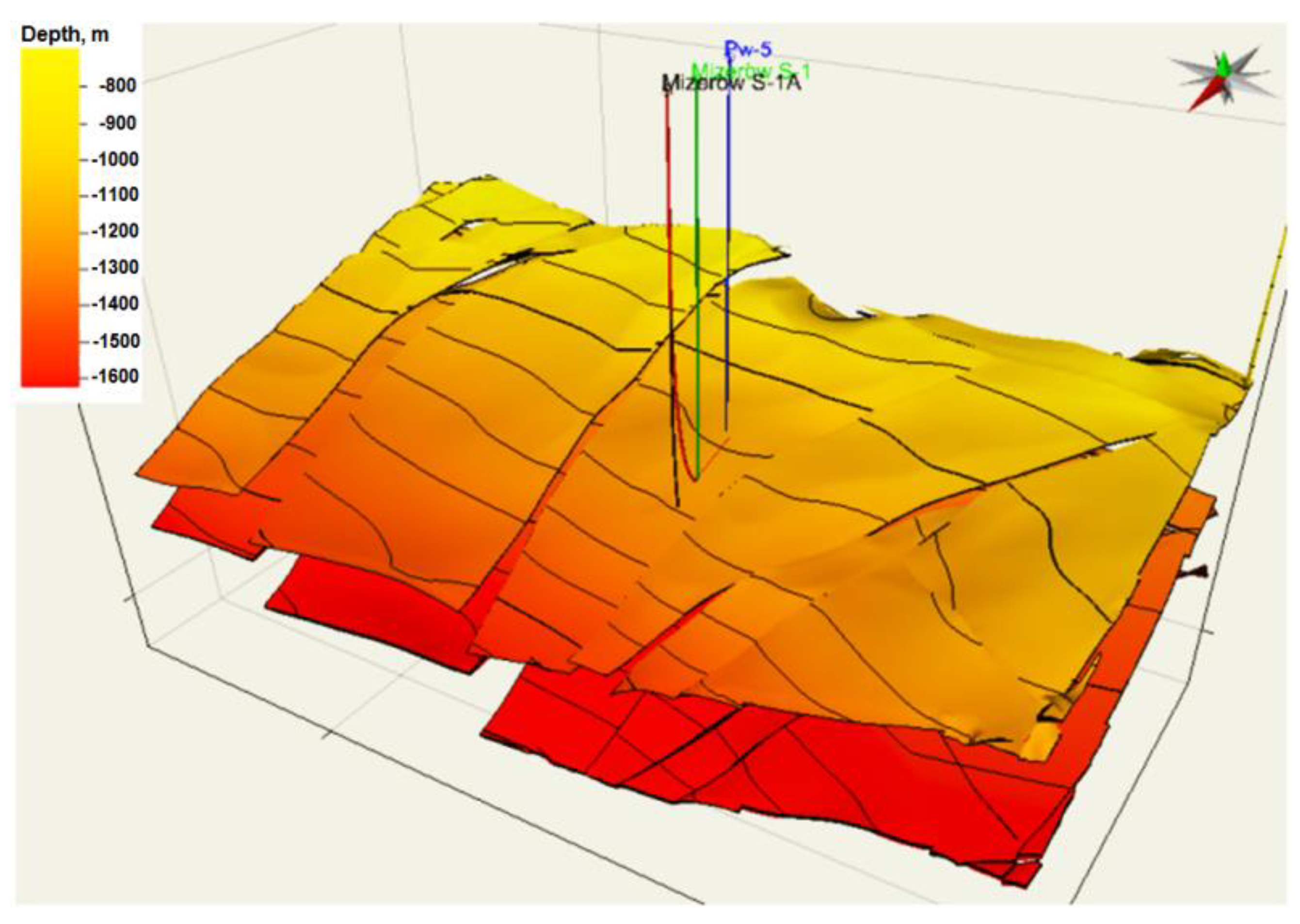
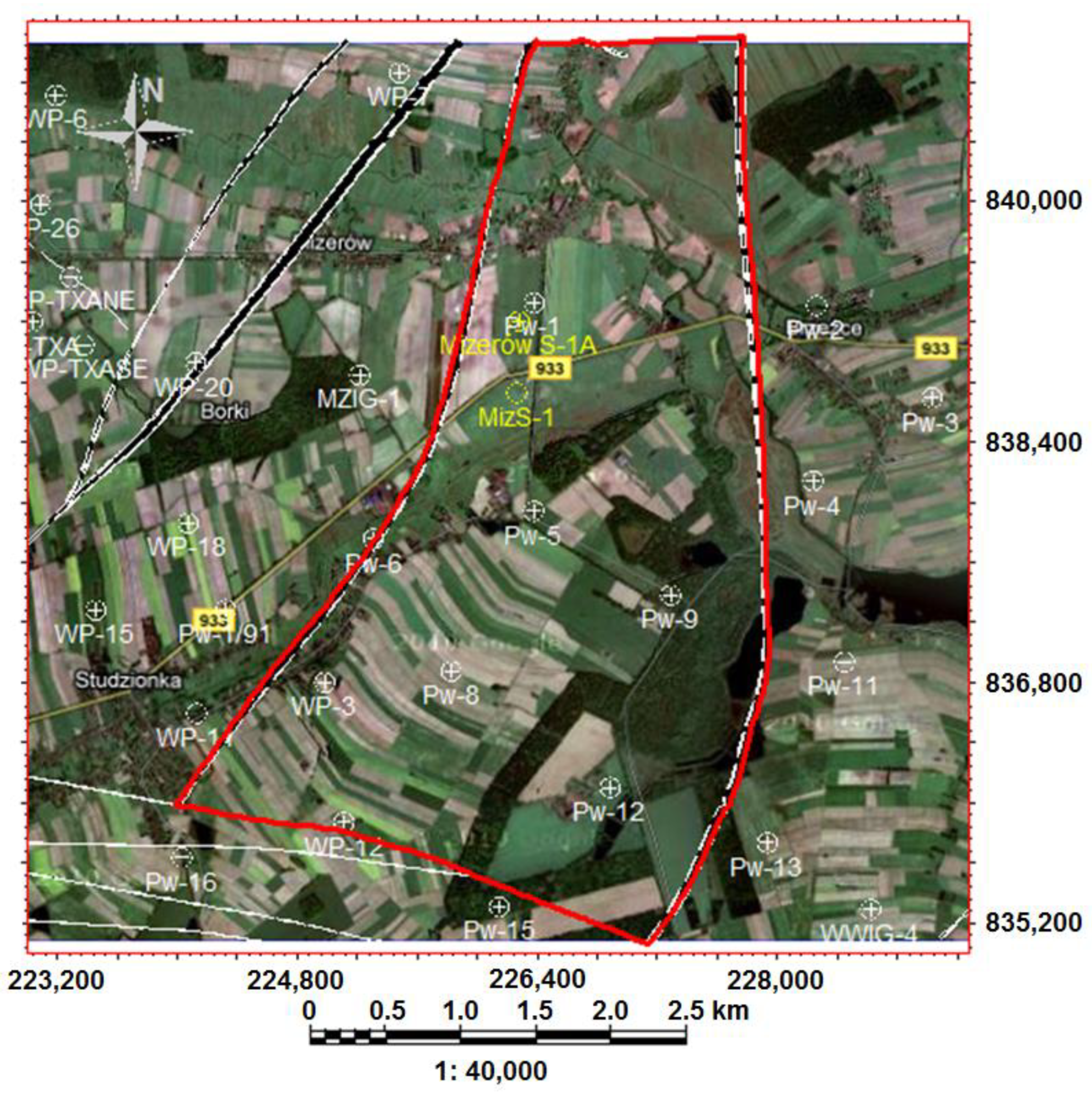

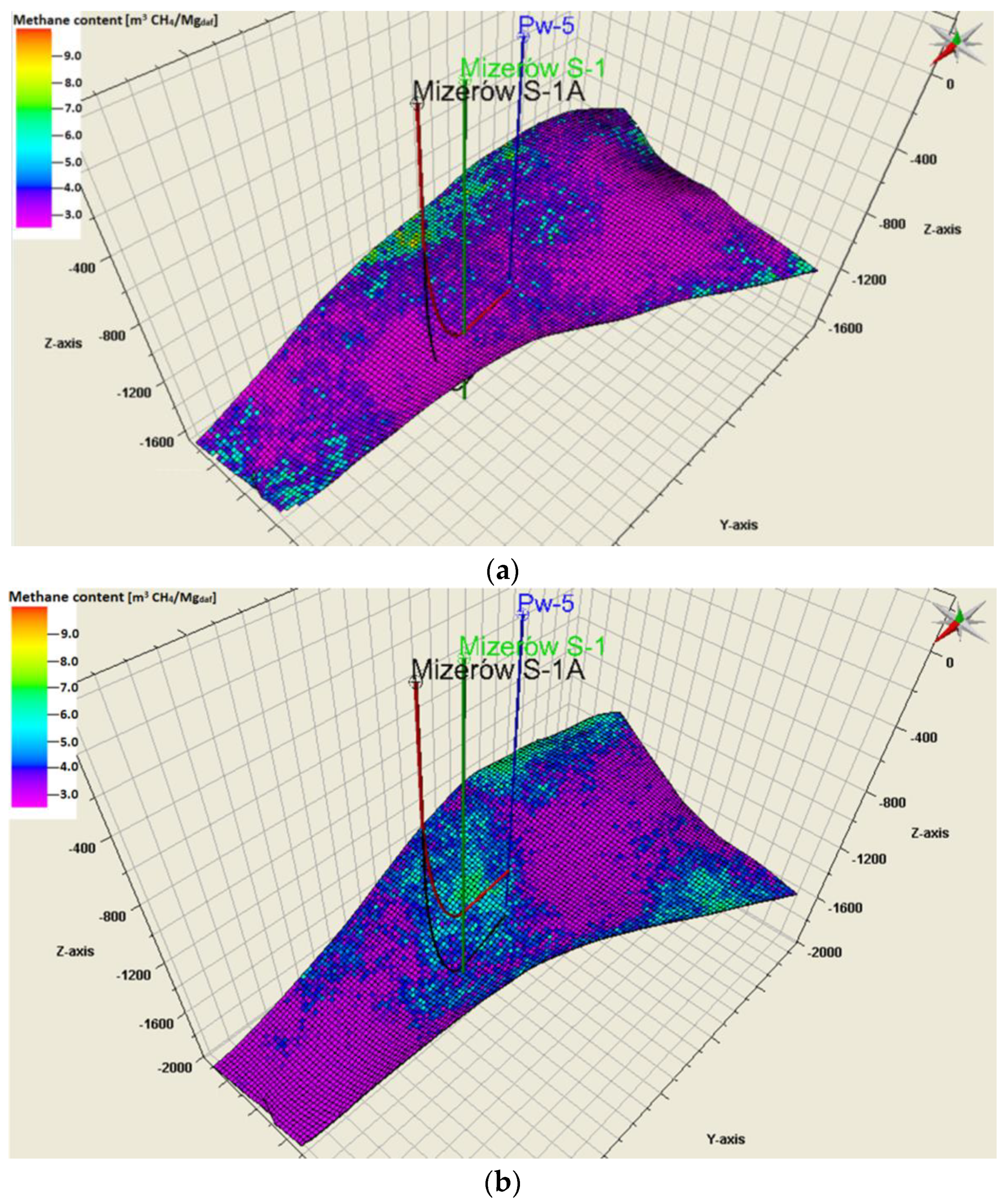
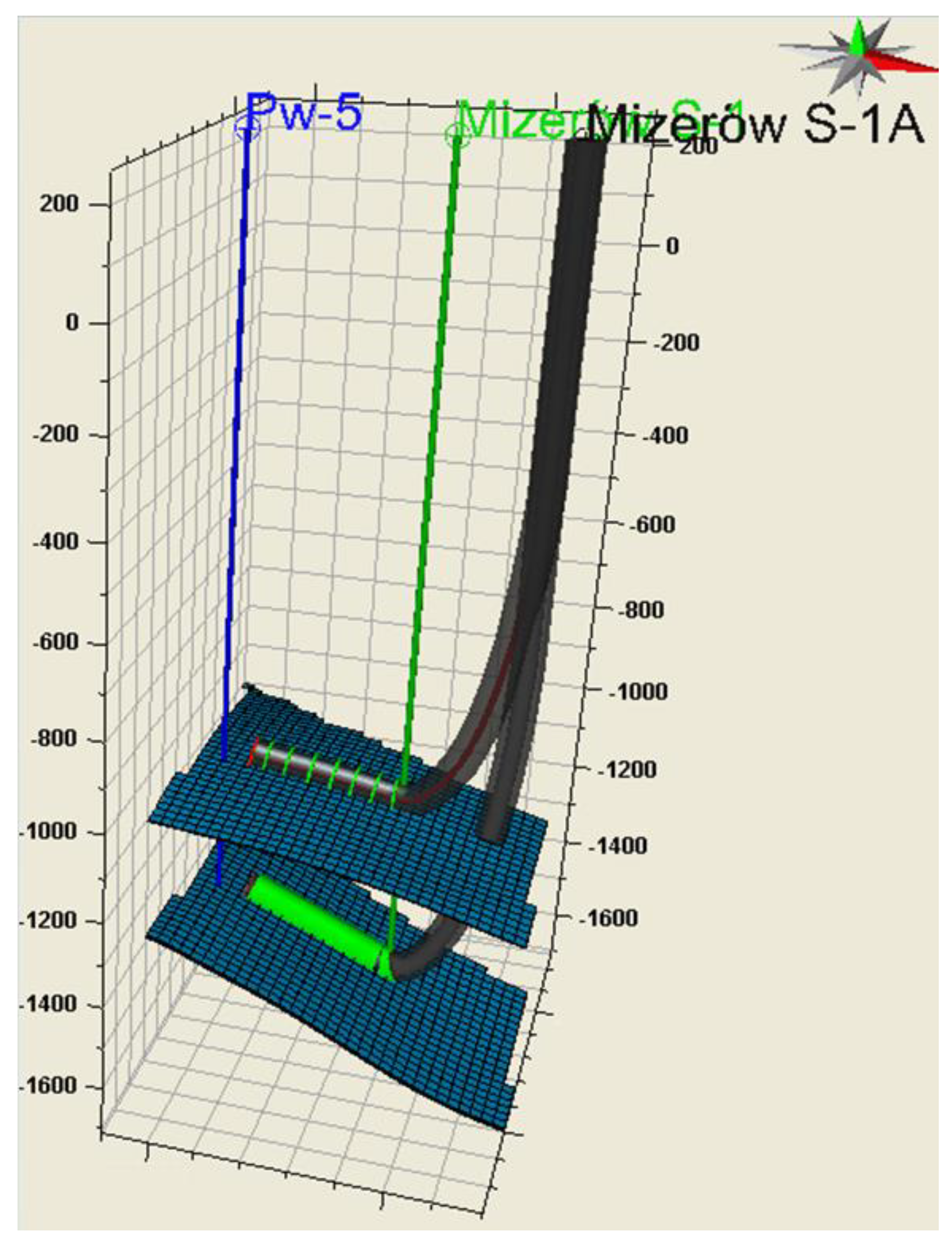
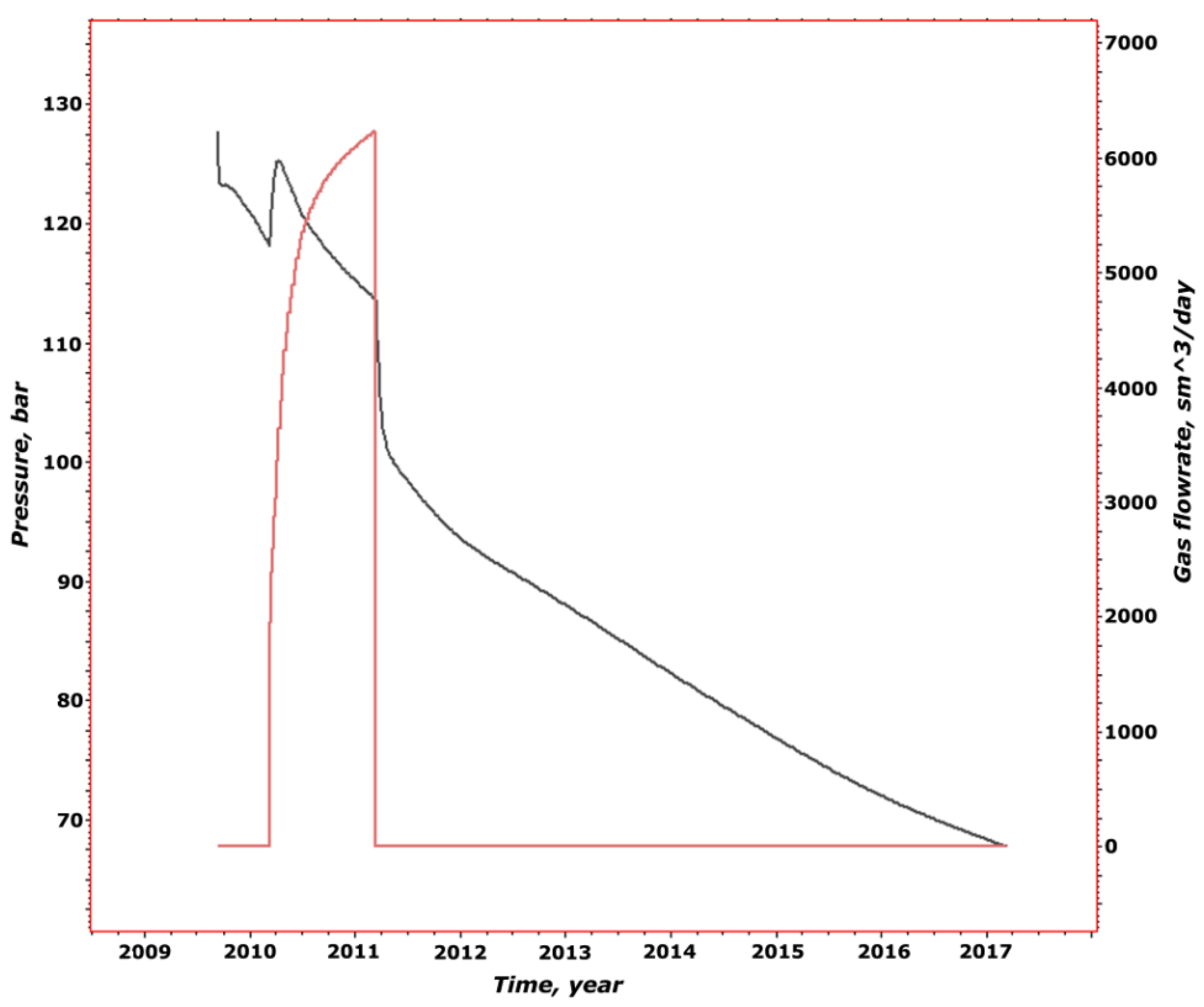
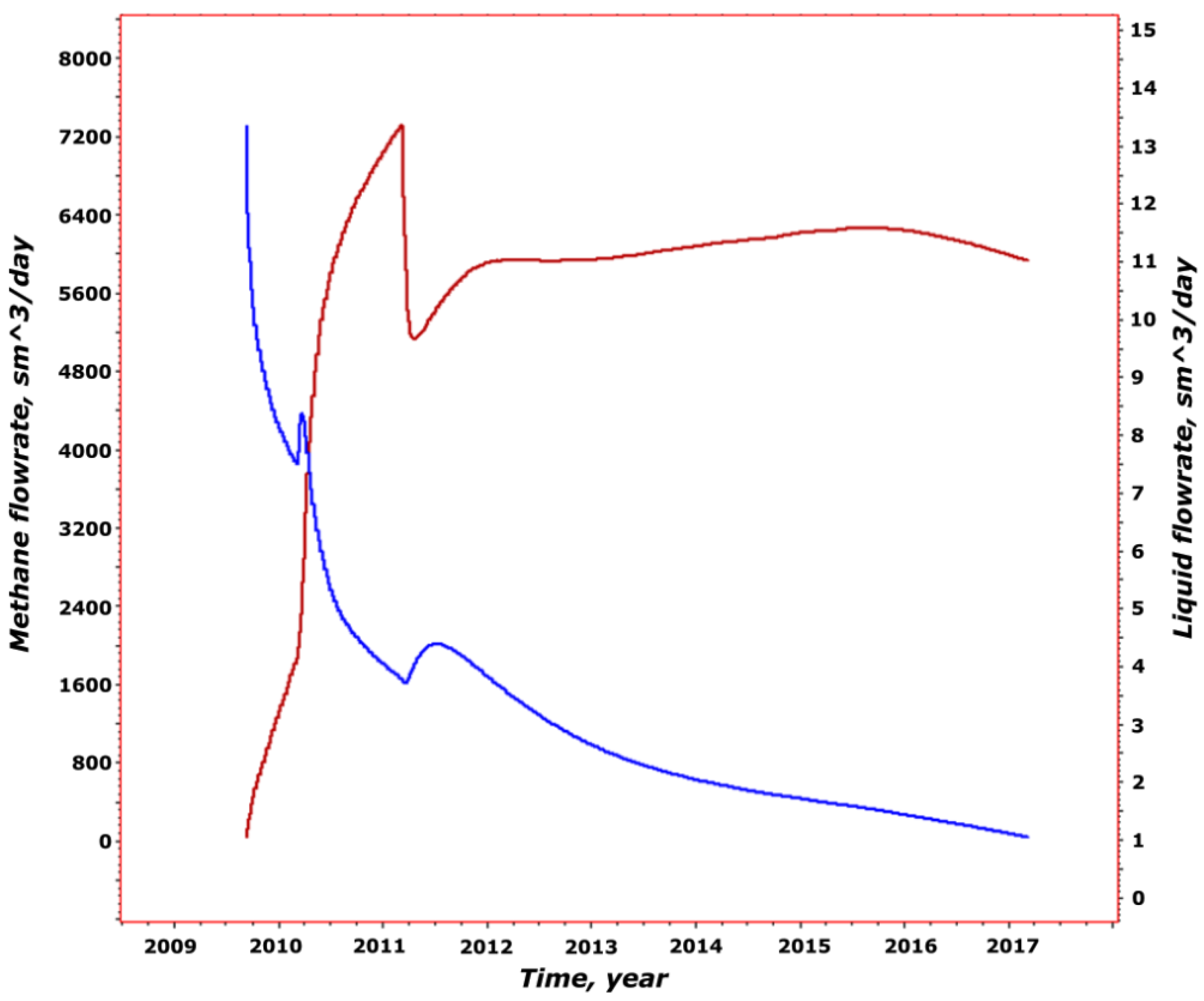
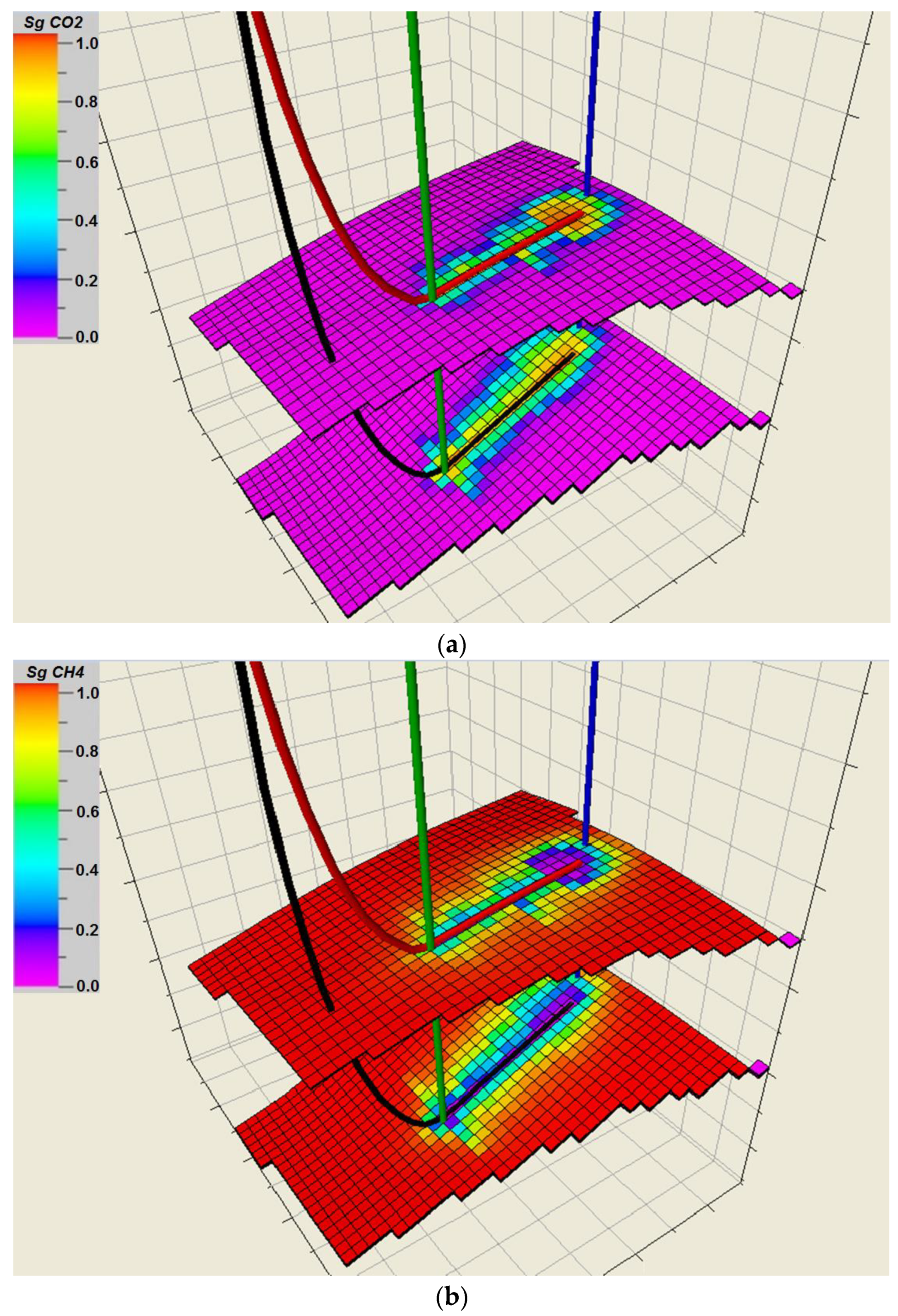

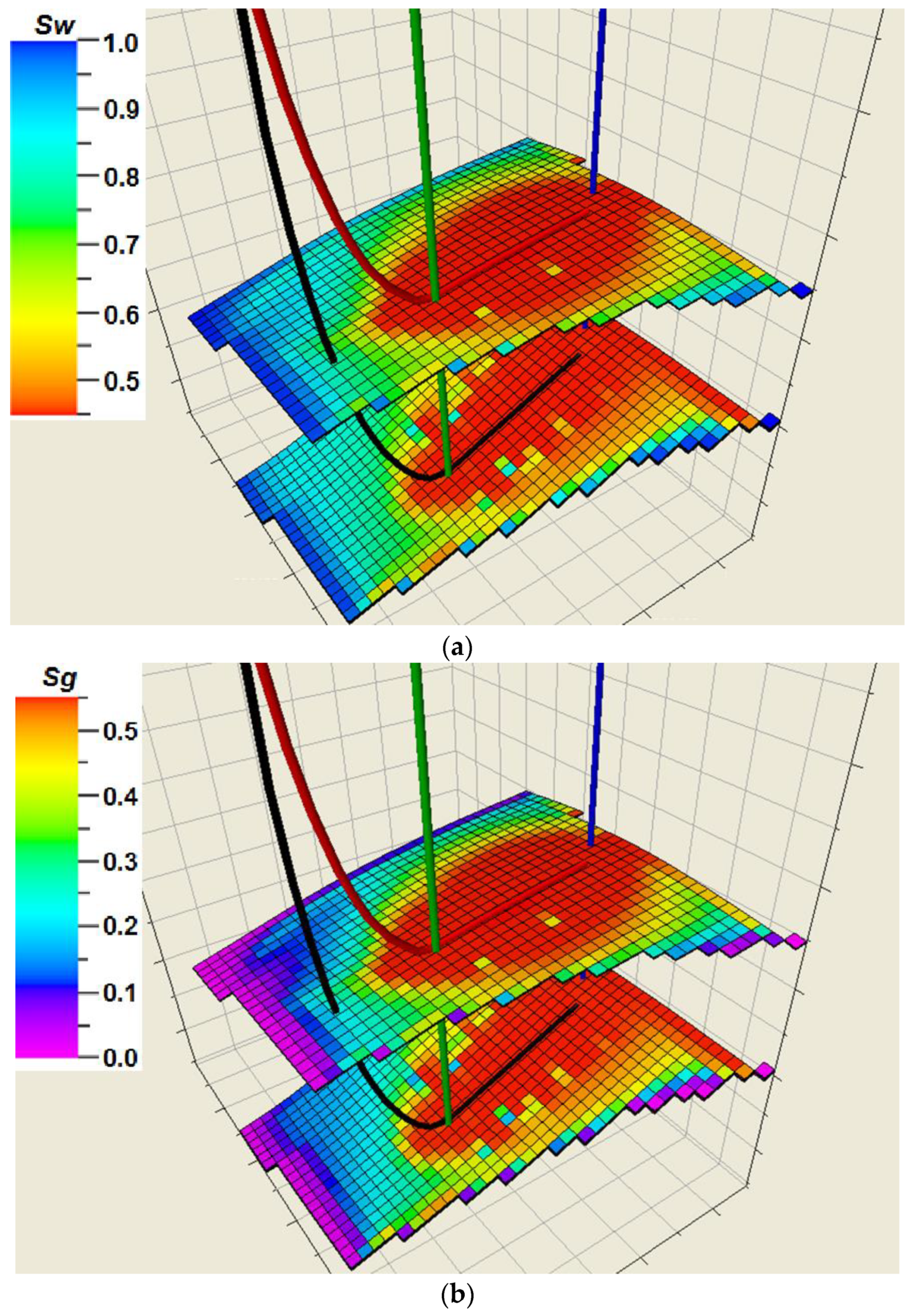
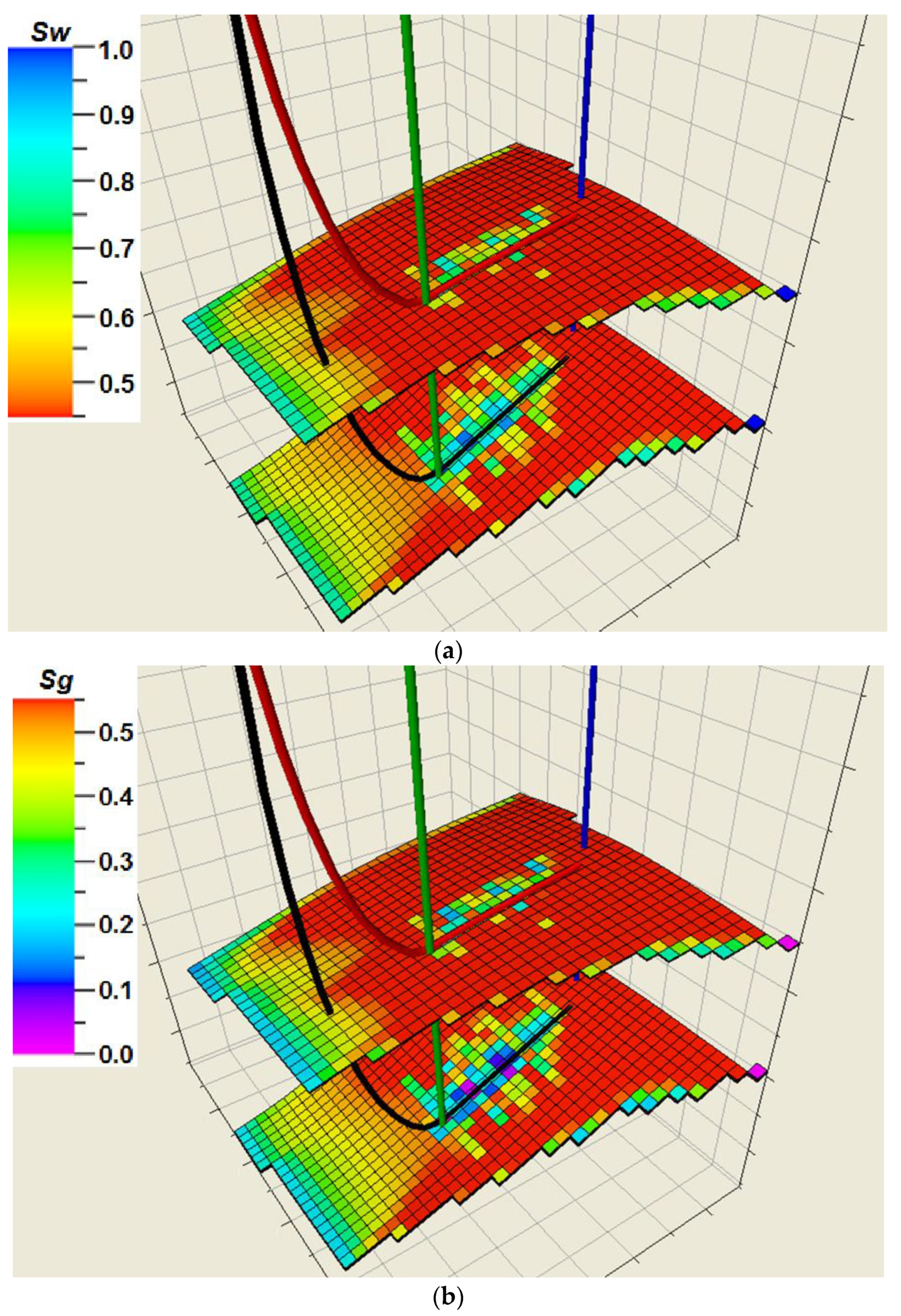
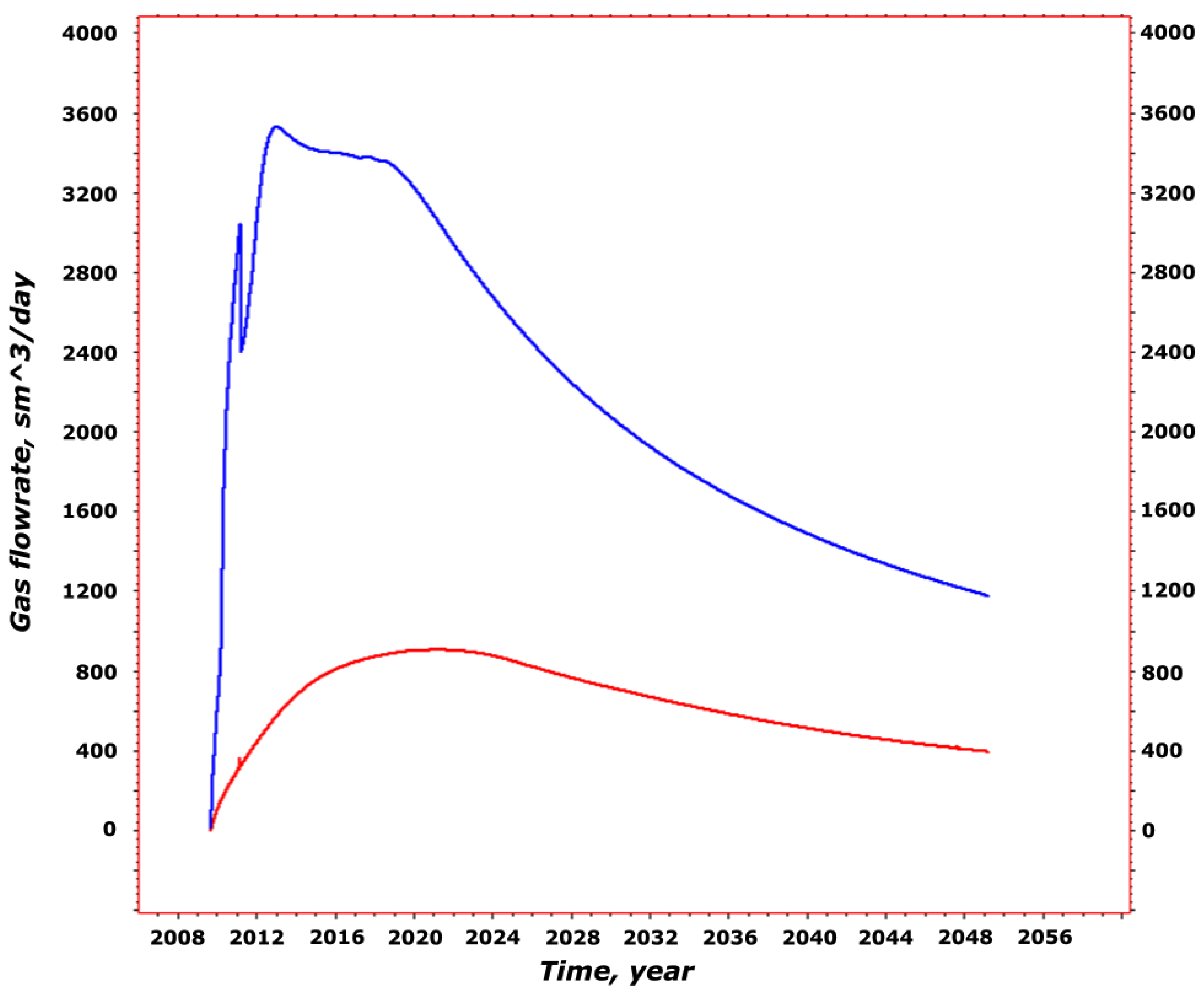
| Lithology Type | Percentage (%) |
|---|---|
| Bituminous coal | 15.90 |
| Claystone | 44.31 |
| Sandstone | 27.40 |
| Mudstone | 12.15 |
| Conglomerate | 0.23 |
| Seam | Methane Content (m3 CH4/Mgdaf) | ||
|---|---|---|---|
| min | max | Average | |
| 405 | 2.54 | 10.05 | 4.20 |
| 510 | 2.98 | 6.76 | 3.80 |
| Parameter | Seam 405 | Seam 510 |
|---|---|---|
| Thickness (m) | 3.0 | 8.0 |
| Depth (m) | 1333–1516 | 1640–1967 |
| The area of the model (m2) | 1,836,790 | |
| Horizontal resolution of the interpolation grid (m) | 50 × 50 | |
| Vertical resolution of the model (m) | 1.0 | 2.66 |
| Fracture porosity (%) | 0.5 | |
| Permeability X,Y,Z (mD) | 1.5 | |
| Parameter | Seam 405 | Seam 510 | Unit |
|---|---|---|---|
| Initial pressure at the injection point | 110.4–115.7 | 143.4–157.3 | bar |
| Coal density | 1330.0 | kg/m3 | |
| CH4 Diffusion coefficient | 0.0000685 | m2/d | |
| CO2 Diffusion coefficient | 0.0001390 | m2/d | |
| Min. Production pressure | 5.0 | bar | |
| Max. Injection pressure | 165.0 | 175.0 | bar |
| Extended Langmuir Isotherm Parameters | |||
| CH4, volume VL | 0.0205 | sm3/kg | |
| CH4, pressure PL | 42.00 | bar | |
| CO2, volume VL | 0.0320 | sm3/kg | |
| CO2, pressure PL | 19.03 | bar | |
© 2020 by the authors. Licensee MDPI, Basel, Switzerland. This article is an open access article distributed under the terms and conditions of the Creative Commons Attribution (CC BY) license (http://creativecommons.org/licenses/by/4.0/).
Share and Cite
Chećko, J.; Urych, T.; Magdziarczyk, M.; Smolinski, A. Research on the Processes of Injecting CO2 into Coal Seams with CH4 Recovery Using Horizontal Wells. Energies 2020, 13, 416. https://doi.org/10.3390/en13020416
Chećko J, Urych T, Magdziarczyk M, Smolinski A. Research on the Processes of Injecting CO2 into Coal Seams with CH4 Recovery Using Horizontal Wells. Energies. 2020; 13(2):416. https://doi.org/10.3390/en13020416
Chicago/Turabian StyleChećko, Jarosław, Tomasz Urych, Małgorzata Magdziarczyk, and Adam Smolinski. 2020. "Research on the Processes of Injecting CO2 into Coal Seams with CH4 Recovery Using Horizontal Wells" Energies 13, no. 2: 416. https://doi.org/10.3390/en13020416
APA StyleChećko, J., Urych, T., Magdziarczyk, M., & Smolinski, A. (2020). Research on the Processes of Injecting CO2 into Coal Seams with CH4 Recovery Using Horizontal Wells. Energies, 13(2), 416. https://doi.org/10.3390/en13020416






